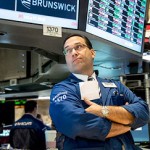U.S. stocks finished lower on Monday

U.S. stocks finished lower on Monday, topping off a wild ride that had the Dow Jones Industrial Average trading in a more than 300-point range on either side of neutral as investors monitored the price of oil.
“Everyone keeps saying how great lower energy prices are, but it’s the major global growth story that is at risk,” said Peter Boockvar, chief market analyst at the Lindsey Group.
“Japan, Europe and Russia are geographies that are struggling, with the U.S. on a relative basis looking like a superstar. But with the gravitational pull on U.S. growth rates and earnings, coupled with a stronger U.S. dollar, 2015 estimates are under re-evaluation, that’s in part what markets are telling us now,” said Jim Russell, portfolio manager at Bahl & Gaynor.
The Dow moved up and down more than 100 points during Monday’s session, and event that last occurred a year and a half ago, on June 12, 2013.
“We’ve got a pattern now of as goes oil, so goes the market. It doesn’t necessarily make sense, but that’s the nature of the beast until it’s not,” said Art Hogan, chief market strategist at Wunderlich Securities.
“When we see any asset class falling precipitously, it’s difficult for other asset classes to catch a bid,” Hogan added.
After falling to a low of $55.87 a barrel, crude-oil futures for January delivery dropped $1.90 to $55.91 a barrel on the New York Mercantile Exchange, its lowest closing level since May 2009.
After surging 78 percent last week, the Chicago Board Options Exchange Volatility Index, a measure of investor uncertainty known as the VIX, fell 3.1 percent to 20.42.
PetSmart gained after agreeing to be purchased for about $8.25 billion by a group led by BC Partners.
Equities offered muted reaction to a gauge of home-builder sentiment falling a point in December after a large jump last month.
A Federal Reserve report had industrial production rebounding in November, after a Fed measure of manufacturing in the New York region dropped in December.
Turning negative after a 122-point jump, the Dow Jones Industrial Average fell as much as 165 points, and ended at 17,180.84, down 99.99 points, or 0.6 percent, with McDonald’s leading blue-chip losses that included 25 of 30 components.
The S&P 500 declined 12.70 points, or 0.6 percent, to 1,989.63, with utilities pacing losses that extended to all 10 major industry groups.
The Nasdaq dropped 48.44 points, or 1 percent, to 4,605.16.
For every share climbing, more than three fell on the New York Stock Exchange, where nearly 980 million shares traded. Composite volume cleared 4.3 billion.
The U.S. dollar gained against other global currencies and dollar-denominated commodities including gold and oil fell.
“There are winners and losers as a result of the fall in oil prices. Overall, lower energy costs are a net positive for the U.S. economy. Energy prices are exacerbating already existing Russian woes, and the ruble fell to record lows versus the dollar,” Bill Stone, chief investment strategist at PNC Asset Management Group, wrote in emailed commentary.
Gold futures for February delivery shed $14.80, or 1.2 percent, to $1,207.70 an ounce.
The yield on the 10-year Treasury note used to figure mortgage rates and other consumer loans rose 3 basis points to 2.1158 percent.
On Friday, U.S. stocks declined, with benchmark indexes posting sizable weekly losses, as crude’s ongoing slide rattled investors.
Source: CNBC – U.S. stocks finished lower on Monday





























